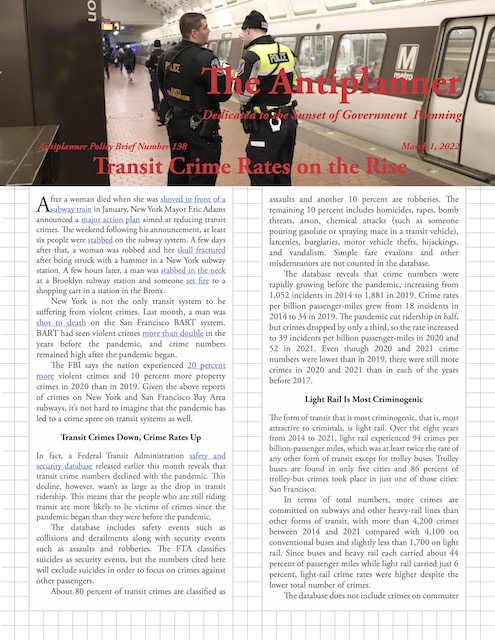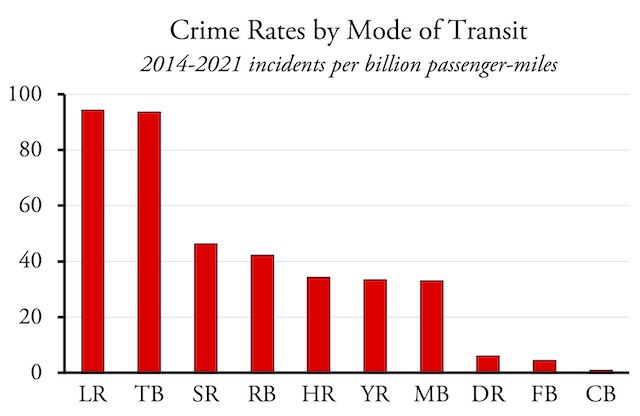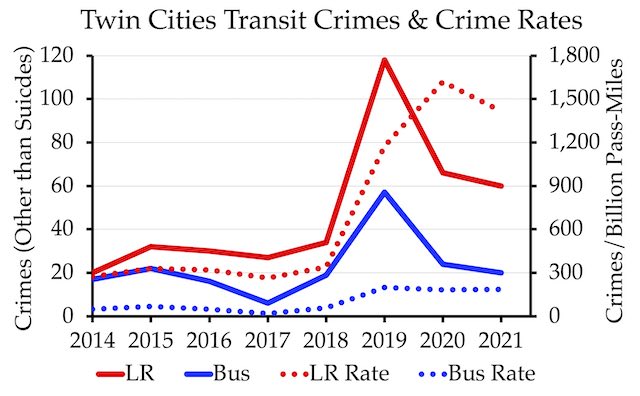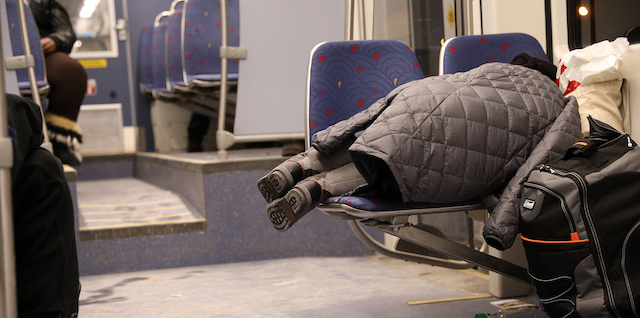After a woman died when she was shoved in front of a subway train in January, New York Mayor Eric Adams announced a major action plan aimed at reducing transit crimes. The weekend following his announcement, at least six people were stabbed on the subway system. A few days after that, a woman was robbed and her skull fractured after being struck with a hammer in a New York subway station. A few hours later, a man was stabbed in the neck at a Brooklyn subway station and someone set fire to a shopping cart in a station in the Bronx.
 Click image to download a five-page PDF of this policy brief.
Click image to download a five-page PDF of this policy brief.
New York is not the only transit system to be suffering from violent crimes. Last month, a man was shot to death on the San Francisco BART system. BART had seen violent crimes more than double in the years before the pandemic, and crime numbers remained high after the pandemic began.
The FBI says the nation experienced 20 percent more violent crimes and 10 percent more property crimes in 2020 than in 2019. Given the above reports of crimes on New York and San Francisco Bay Area subways, it’s not hard to imagine that the pandemic has led to a crime spree on transit systems as well.
Transit Crimes Down, Crime Rates Up
In fact, a Federal Transit Administration safety and security database released earlier this month reveals that transit crime numbers declined with the pandemic. This decline, however, wasn’t as large as the drop in transit ridership. This means that the people who are still riding transit are more likely to be victims of crimes since the pandemic began than they were before the pandemic.
The database includes safety events such as collisions and derailments along with security events such as assaults and robberies. The FTA classifies suicides as security events, but the numbers cited here will exclude suicides in order to focus on crimes against other passengers.
About 80 percent of transit crimes are classified as assaults and another 10 percent are robberies. The remaining 10 percent includes homicides, rapes, bomb threats, arson, chemical attacks (such as someone pouring gasoline or spraying mace in a transit vehicle), larcenies, burglaries, motor vehicle thefts, hijackings, and vandalism. Simple fare evasions and other misdemeanors are not counted in the database.
The database reveals that crime numbers were rapidly growing before the pandemic, increasing from 1,052 incidents in 2014 to 1,881 in 2019. Crime rates per billion passenger-miles grew from 18 incidents in 2014 to 34 in 2019. The pandemic cut ridership in half, but crimes dropped by only a third, so the rate increased to 39 incidents per billion passenger-miles in 2020 and 52 in 2021. Even though 2020 and 2021 crime numbers were lower than in 2019, there were still more crimes in 2020 and 2021 than in each of the years before 2017.
Light Rail Is Most Criminogenic
The form of transit that is most criminogenic, that is, most attractive to criminals, is light rail. Over the eight years from 2014 to 2021, light rail experienced 94 crimes per billion-passenger miles, which was at least twice the rate of any other form of transit except for trolley buses. Trolley buses are found in only five cities and 86 percent of trolley-bus crimes took place in just one of those cities: San Francisco.
The database indicates that, from 2014 through 2021, light-rail attracted far more crime than any other form of transit except trolley buses, and almost three times as much, per billion passenger-miles, as heavy rail or buses.
In terms of total numbers, more crimes are committed on subways and other heavy-rail lines than other forms of transit, with more than 4,200 crimes between 2014 and 2021 compared with 4,100 on conventional buses and slightly less than 1,700 on light rail. Since buses and heavy rail each carried about 44 percent of passenger miles while light rail carried just 6 percent, light-rail crime rates were higher despite the lower total number of crimes.
The database does not include crimes on commuter trains, probably because those trains are regulated by the Federal Railway Administration rather than the Federal Transit Administration. The data do include commuter buses, which serve a similar market to commuter trains, and crime rates on those buses (which carry almost as many passenger-miles as light rail) were very low.
Heavy-Rail Crimes
Despite the horrendous reports of violent crimes on the New York City subway, that system did not have a particularly high crime rate, suffering just 22 incidents per billion passenger-miles over the 2014 to 2021 time period in the database. This was below average for heavy rail as a whole, which was 34 incidents per billion passenger-miles. The highest heavy-rail crime rates were reported by the Staten Island Railway (113 per BPM), followed closely by Philadelphia’s SEPTA lines (110), both of which were five times greater than New York City subway rates. Rates were also much higher than average in Los Angeles (72), Cleveland (66), Boston (61), Chicago (57), and Atlanta (51).
Light-Rail Crimes
None of these come close to the crime rate on the Minneapolis-St. Paul light-rail system. Over the eight-year period, it suffered more than 400 crimes per billion passenger-miles, a figure that climbed to more than 1,600 in 2020. Houston (260) was a distant second followed closely by San Jose (254). Except for Dallas (139), every other light-rail system was below average for light rail, not that this means much considering how high the average was for light rail. Though below average for light rail, crime rates were high in Newark (87), Norfolk (80), Portland (79), Los Angeles (77), Sacramento (74), Buffalo (66), Phoenix (52), and St. Louis (47).
Crime rates on Twin Cities light-rail trains were already higher than any other system in the country in 2018, then took a huge leap in 2019 and 2020.
The reported numbers for some cities might be questionable. For example, Baltimore is noted for having one of the highest violent crime rates in the country. Yet Maryland transit reported just 3 light-rail crimes a year in 2014 through 2016, and zero crimes from 2017 through 2019. It also reported zero crimes on its heavy-rail line in the same years and zero on buses in 2018 and 2019. These numbers might be correct, but if not, then Baltimore probably suffers much higher transit crime rates than reported in the FTA’s database.
One reason why light rail might suffer higher crime rates than buses is that the light-rail driver is secluded in a separate compartment, while bus drivers are in the same compartment as passengers, and thus able to act as a check on poor behavior. However, heavy-rail drivers are also secluded yet crime rates are much lower than on light rail.
Crime and Fare Evasion
A more important reason why light rail suffers the highest amount of transit crime is fare enforcement, or a lack of it on light rail. While heavy-rail lines have turnstiles requiring people to pay fares before boarding the trains, and most bus systems require drivers to enforce fare payment, light rail has no turnstiles and only sporadic fare enforcement by on-board fare inspectors. Under the “broken-windows” hypothesis, enforcement of minor crimes such as fare evasion will discourage more serious crimes.
The fare issue also explains the high crime rate on San Francisco’s trolley buses. Unlike most bus systems, San Francisco does not require drivers to collect fares, instead relying on fare inspectors. But the fare inspectors have proven to be somewhat lazy, doing nearly all of their work within a few blocks of the transit agency’s headquarters. The result is that both trolley buses and conventional buses in San Francisco have much higher crime rates than other bus systems in the country.
The broken-windows hypothesis was proven in New York City, which suffered high rates of subway crime in the 1980s. In 1990, the chief of New York’s transit police implemented a strict policy of enforcing fare evasions and other minor crimes that resulted in a dramatic reduction in violent crimes on the subway.[i]
Unfortunately, this also led to charges that the transit police were discriminating against blacks and other minorities. “Police intervention has contributed to reduced incidents of violent crime,” admits the New York-based TransitCenter, “but it has had tradeoffs. The overreliance on police for routine safety issues often makes riders less safe, as police response to ‘code of conduct’ issues like putting feet on seats, eating food, or not paying the fare is consistently discriminatory against Black and brown riders and regularly escalates into incidents of brutality.”
Not surprisingly, light-rail crime has become a major issue in the Twin Cities. Crimes are so common on the system that light-rail drivers say they are afraid to come to work. If the drivers are afraid of being on light-rail trains, then certainly the passengers are as well.
The solution is to make fare evasion difficult without making it a major police issue. San Francisco should return to the system of having bus drivers collect fares or require proof of payment. Operators of light rail should install gates and turnstiles at every light-rail station that are at least as restrictive as those for heavy-rail lines, if not more so. Doing so would not be cheap, but it would provide riders with greater security. Without such security, transit ridership recovery will be hampered even more than it has been by the pandemic.
Homelessness and Crime
Homelessness is another factor that may be partly responsible for the increasing rate of transit crimes in recent years. The New York City transit authority reports that around 350 homeless people are living in subway stations, and many of the recent violent crimes were committed by homeless people.
In 2019, San Jose’s Valley Transportation Authority (VTA) operated an all-night bus, route 22, that was locally known as “hotel 22” because it was used by homeless people as a shelter. When cash-strapped VTA proposed to cancel this bus route, homeless advocates demanded that the agency continue running it as a “lifeline” for homeless people. But turning transit vehicles into shelters for homeless people does a disservice for both those homeless people and for other transit riders.
Hundreds of people used Twin Cities light-rail trains as homeless shelters in the winter of 2018-2019, when Metro Transit ran the trains all night long. Metro Transit photo.
In that same year, the Twin Cities Metro Transit reported that its light-rail trains, which also ran all night, had become winter shelters for as many as 430 homeless people. It experienced a debate similar to that in San Jose when it eliminated service between 2 am and 4 am, thus displacing those riders.
Unfortunately, the FTA security database doesn’t have homelessness as a variable, so it is difficult to know how homelessness is related to transit crime. The fact that crime problems are most serious on transit systems that don’t actively require fare payment, which means they are accessible by homeless people, suggests that it is.
According to the National Alliance to End Homelessness, more than 647,000 people were homeless in 2007. This steadily declined to under 550,000 by 2016, but since then has increased to more than 580,000 people in 2020. Of those, 120,000 were considered chronically homeless—continuously homeless for more than a year or homeless at least four times in the previous three years—in 2007, declining to 87,000 in 2016 but rising again to more than 110,000 in 20120.
“The solution to homelessness is simple,” says the Alliance: “housing” or, more precisely, “rapid re-housing” in the form of short-term rental assistance. While this may work for some homeless people, I can’t help but feel that homelessness is too complicated a problem to have such a simple solution. If it were so simple, then why is homelessness increasing?
I’m not an expert on homelessness, but I suspect that being homeless is a symptom, and it won’t be fixed until the underlying problems are solved. For some, those problems may be the loss of a job and difficulty of finding a new job when lacking a stable home. Rapid re-housing may work for such people. For others, however, the underlying problems may be mental illness, drug addiction, or simply an unwillingness to work. Rapid re-housing isn’t going to work for them, and they are the ones most likely to commit crimes.
Unfortunately, the homeless issue is dominated by for-profit and non-profit organizations seeking government grants to build new housing. These groups have little incentive to consider the underlying problems; they consider it a victory if they re-house some people even if the chronically homeless remain on the streets.
Whatever the solution, it doesn’t involve using transit vehicles as homeless shelters. This does a disservice to homeless people, who can’t be comfortable sleeping on transit seats designed for short rides, as well as to other transit riders, who may not feel safe sharing their rides with the homeless. Transit agencies need to recognize whether recent increases in crime are related to recent increases in homelessness, and if they are, take actions to reduce such crime. Fare enforcement would be one of the most important such actions.
In many cities, the long-run solution is to stop building light-rail transit and concentrate instead on running safe, efficient buses with traditional fare enforcement. Light rail is obsolete in many ways, and the fact that it is so criminogenic is just one more reason not to build it.
[i]. Nicole Gelinas, “How to Increase Public Safety on NYC Subways: Correct the Balance Among Lower Ridership, Higher Crime, and Proactive Law Enforcement,” Manhattan Institute, 2021, https://www.manhattan-institute.org/how-increase-public-safety-nyc-subways.











When government who runs your city, have a political motivation to pander to people who’re dysfunctional, poorly behaved, engage in lewd or self destructive acts, their policies do nothing but foster more dysfunctionality, poor behavior and lewd acts and disavowing self respect and personal dignity. Once self respect and personal dignity are gone which can be obliterated quickly it takes years to build it back. Then your cities problems of the consequences of people who have zero dignity and self respect……only continue to get worse. And they foster this based supposed racial inequity, equality, socio-economic analysis?, the result is they and the media turn a blind eye to any form of disruptive and poor behavior.
Even Worse when you indoctrinate the entitlement mentality on those dysfunctional people you embolden them to be angry or violent when they don’t get their way…where does that behavior sound familiar? AMONG CHILDREN, the difference is adults are stronger, and have access to guns. If you subsidize a culture of degeneracy and debasement, you make it attractive for more people. If you turn a blind eye to ejaculating on a train or shitting on the sidewalk or shooting up heroin on the streets, don’t be surprised if people start ejaculating on a train or shitting on sidewalks or shooting up or picking fights. YOU’RE GOING TO GET MORE OF IT.
Combine with it an entertainment and urban culture that glorifies drug abuse, illicit activities, gun violence, criminality and abuse against woman and distrust and enmity against law enforcement, DON’T BE SURPRISED when EXACTLY THAT kind of behavior proliferates in your neighborhood when you encourage Children to Enjoy it. Ent/Urban culture is a laser guided weapon that targets the most naive or financially irresponsible people.
-90s: Fuck the POLICE
-2000’s: STOP SNITCHING
– 2020’s: DEFUND the police
”Why is there so much crime?”
The real reason: City leaders have no incentive to care about the well being of their citizens or public face. Their re-election is guaranteed. Since transit is viewed by most as an environmental, economical, social and moral public good, any attempt to decry it, curtail, shut it down is viewed as racist/bigoted/elitist; No matter How miserable public services get, the democrats will win predominantly any major city election. And public sector work are predominantly democratic loyal.
Isn’t traffic violence also on the rise in the USA?
https://news.yahoo.com/woman-smeared-face-human-feces-162046932.html
Woman smeared in the face with human feces on New York City subway platform
Sketter,
A lot of things are on the rise. I can only cover one thing in a blog post. I’ll have a blog post about traffic fatalities later this week.
“Woman smeared in the face with human feces on New York City subway platform”
Pavement apes gonna do their thang.
A very good post. A huge problem with BART is fare evasion leading to crime. See:
https://www.ktvu.com/news/violent-crime-soars-on-bart-fare-evasion-costs-25m-a-year-grand-jury-report
https://www.sfgate.com/local-donotuse/article/How-bad-is-BART-fare-evasion-We-saw-90-people-in-13186006.php
”
Isn’t traffic violence also on the rise in the USA?
” ~sketter
The only traffic violence I’ve seen recently was in Winnipeg when an extremist ran some protesters over.
For the most part, traffic violence is rare in the US.
Now if you’re playing word games and trying to claim that accidents are “traffic violence”, well, you’re playing games. Violence means choosing physical force, not merely something physical occuring.
Do you prefer to use the term?
1. Traffic Violence
2. Traffic Crash
3. Traffic Accidents
Best summed up in the Simpsons episode “Brake my wife…Please” Where after getting his license revoked Homer must attend other means of transport
Homer: “Public transit is for jerks and Lesbians”
In effect, he starts walking
prk166, it’s a good point worth remembering, as the Antiplanner is constantly emphasizing. A death by train is a tragedy worth mourning. A death by a car is a per-million-mile statistic.
janehavisham, you’re claiming that Mr. O’Toole does not care that people die. That’s a pretty vile claim.
”
Do you prefer to use the term?
” ~ sketter
There is no excuse for perverting the meaning of words to create vapid rhetoric for your shallow ideological religion.
You still didn’t answer my question.
Sketter, there’s nothing clever about what your doing. It’s childish and bullheaded. You insist on a using a word that’s clearly not applicable as a descriptor. 99% of the people see that. Then you play some game about questions. Sad, childish crap.